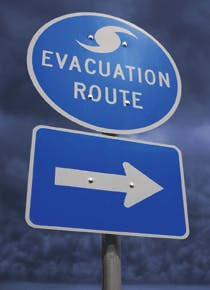Will Your Facility Be Ready … When Disaster Strikes?
Most disasters are predictable. While we might not know the exact time or date that a disaster will hit, facilities that are proactive in identifying risk factors typically have good visibility into the various types of incidents that could affect their sites.
Disaster plans – sometimes called business-continuity plans – help facilities keep employees safe, protect essential functions, mitigate unreasonable hazards and recover quickly after any type of major incident.
Starting from Scratch
According to the Insurance Information Institute, up to 40 percent of businesses never reopen after a disaster. Whether the disaster is destructive (like a flood or an explosion) or disruptive (like a flu pandemic), having plans in place to recover from an incident or cope with staffing interruptions can mean the difference between restoring operations and shuttering a facility forever.
While having adequate insurance is essential, insurance isn't enough to ensure that a facility fully can recover from a devastating incident. Insurance can't replace vital records that are destroyed – or restore a long-established customer base that likely will be lost if a facility needs 18 months to rebuild.
Each facility has a unique set of risks, based on geography, processes, workforce demographics and many other factors. As with most preventative plans, evaluating these risks can take time. But the evaluation process can be a tremendous learning experience that gives planners an opportunity to create thorough protocols that enable facilities to account for employees, maintain essential functions and quickly restore operations – so that when disaster strikes, key personnel don't waste time deciding how to respond.
Identifying Resources
Disasters magnify the fact that the workforce is a facility's most important asset. It might be essential to have backup records, power sources, computers, response supplies, processing facilities and warehouse space. However, without plans to notify, account for and sustain employees, physical assets are useless.
As disaster plans document the types of resources that might be needed and how to obtain them, they also should include who is responsible for obtaining or operating each resource. Having a robust incident management system in place can help manage human and physical resources during and after an incident.
Communication
While the rise of digital communication and mobile technology has made it easy to find out what your favorite celebrity is eating for breakfast (in real time), many first responders identify communication as a weak link during drills and actual emergencies.
Good communication involves delivering the appropriate messages to a range of audiences, which is why disaster plans should identify the potential audiences and address their respective needs. For example:
• Employees will need to know if, when and where to report to work.
• Family members will need updates on the status of their loved ones.
• Community members will want to know how an incident affects them.
• Customers will want to know what to expect if business is disrupted.
The media also will want information. By having plans in place to provide key information to the press, media outlets can help facilities communicate important messages to stakeholders and the public.
Regulators also might require detailed information during or after an incident. Assigning someone the responsibility of documenting communications and other details of an event can be helpful for post-incident reports that need to be filed.
Maintaining contact lists can be tedious. However, insufficient or out-of-date contact information for employees can delay communication efforts. These lists also can provide a basis for employee-assistance services that might be necessary after tragic incidents.
Maintaining external contact lists for suppliers and services is another important planning detail. If a facility needs a backhoe at 4:30 p.m. on a Friday afternoon, and the only number listed in the emergency plan is out of service, it might be difficult to locate another backhoe before the remaining rental facilities in the area close for the weekend.
Supplies
Tight budgets can make it difficult to rationalize spending money on emergency supplies that might not be used. Food, water, flashlights, cots and backup power generators are among the emergency supplies that might be needed to sustain employees trapped on site during a flood, blizzard, earthquake or other disaster that cuts off access to or from the facility. Involving employees in the planning process can help facilities devise creative, low-cost solutions.
For example, if there's a space to store supplies, a “fill-the-closet” contest that encourages everyone to bring in extra sleeping bags and blankets can help ensure that those items are stocked and ready. Similar programs could be set up for other essentials. Local emergency management agencies also might be able to assist with resources for low- or no-cost emergency supplies.
Training
Being able to respond to an emergency quickly, safely and effectively does not come naturally to most people. Even with extensive, well-written plans, controlling the human factor during an incident can be one of the most difficult elements of a response – especially if there's a lack of training.
Training employees on the types of incidents that could occur and what their roles are during emergencies helps them to know what actions they can take to stay safe. Some types of training are required by OSHA, EPA, DOT and other regulations. Incorporating disaster scenarios into these training sessions and exercises can help gauge understanding and help ensure that employees will be able to carry out their responsibilities when an incident occurs.
Everyone should know how to evacuate and where to assemble after an evacuation. Employees also should be able to identify response coordinators, team leaders and others who may have leadership roles during an emergency. They also should understand why it's important to control who talks to media representatives and who is designated to speak to the media.
When employees understand that most disasters are predictable, it's easier for them to understand how plans and training can help them prepare. Facilities that are prepared for emergencies are better able to respond, recover and rebuild quickly – no matter what type of disaster strikes.
Karen Hamel is a technical specialist for New Pig Corp. She has more than 20 years of experience helping EHS professionals meet EPA, OSHA and DOT regulations. Contact her at (800) 468-4647 or at [email protected].

